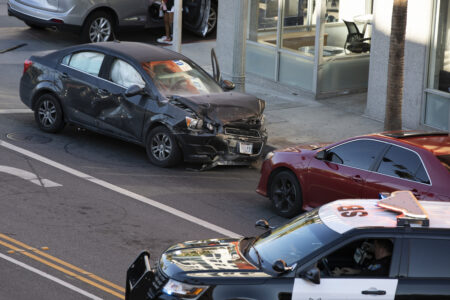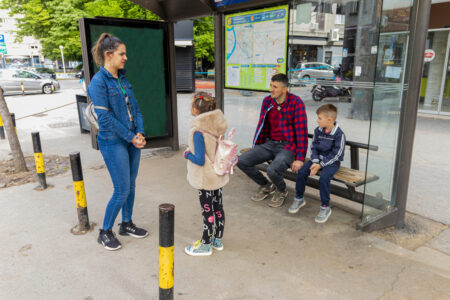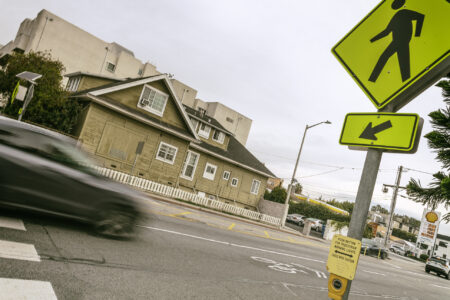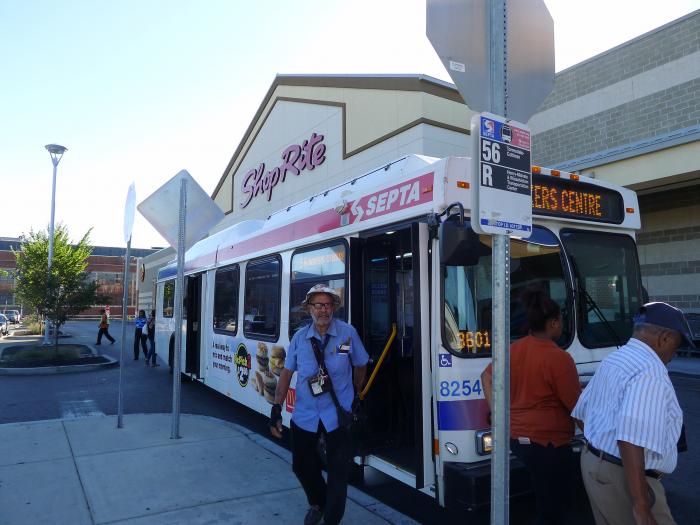
Share On Social!
Everyone deserves a safe and reliable way to get to healthy food—whether a supermarket, corner store, food bank, farmers market, or community garden.
Unfortunately, many Latinos and people in low-income communities, rural communities, and communities of color are disproportionately burdened by long and unreliable commutes, as well as unsafe routes to nutritious food.
That’s why the Safe Routes to Healthy Food Task Force worked for two years to refine the concept of safe routes to healthy food.
Now they’ve released a new report with policy implications, opportunities, and recommendations.
“This collaboration demonstrated that improving access to healthy foods for people without cars can be improved by a variety of sectors, including: transportation, healthy food access, housing, racial and social equity, environmental justice, public health, academia, law, community organizing, and more,” according to the task force’s Safe Routes to Healthy Food Report and Action Agenda report, facilitated by Safe Routes National Partnership with funding from Voices for Healthy Kids.
1. Defining the Problem of Healthy Food Access and Transportation
Transportation challenges among low-income families ultimately comes down to low access to nearby destinations and vehicles without alternative travel options.
People in low-income areas spend 30% longer traveling to the grocery store than the 15-minute average for the nation, putting them at a disadvantage in terms of quality and affordability of food, as well as in terms of safety and time spent commuting.
Sprawling and separated land use practices have resulted in greater distances between destinations, and inadequate infrastructure for walking and biking and underfunded transit have resulted in dependence on vehicles, especially for Latinos, according to a Salud America! research review.
For example, sidewalks are only present in 49% of low-income neighborhoods compared to 89% high-income neighborhoods, according to the report.
Moreover, many private developers plan and build large scale developments, like shopping centers, without taking bus service into consideration. Congestion mitigation strategies for big projects often reinforce dependence on vehicles and reduce viability of walking, biking, and public transit.
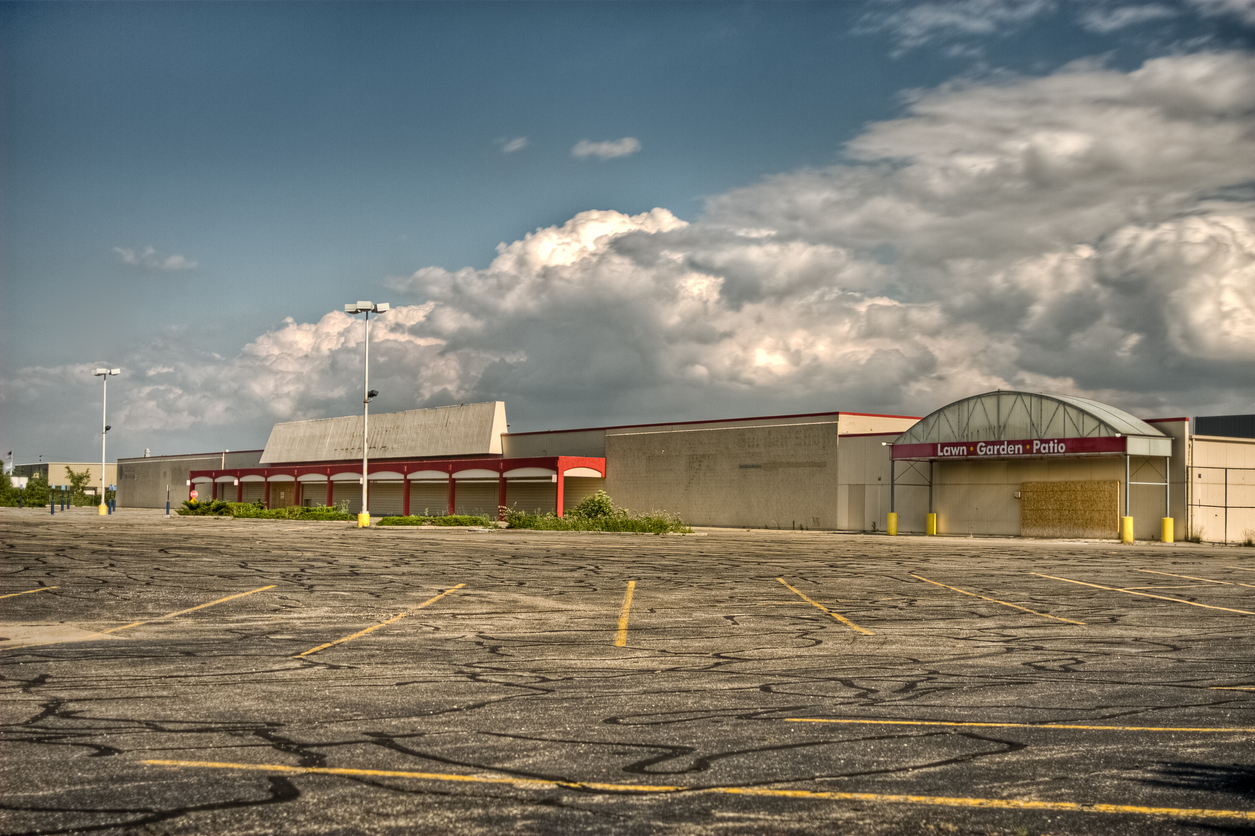 The problem is that vehicles are expensive, dangerous, and dirty.
The problem is that vehicles are expensive, dangerous, and dirty.
Owning and operating a new car costs roughly $8,800 per year. Conservative estimates suggest that owning and operating used vehicles add up to $25,000 over 5 years.
More Latino households do not have access to a car (12%) than White households (6.5%), according to a Salud America! research review.
Without nearby grocery stores, people must travel further or rely on corner stores, which often sell food that is poorer in quality and more expensive.
Reliance on friends, family, taxis or inconvenient and unreliable transit to the grocery store takes more time and may result in shopping less frequently and purchasing fewer fresh foods.
Without crosswalks, sidewalks, and bike lanes, people walking and biking are at increased risk of injury or death.
The impact of the lack of safe infrastructure can be deadly.
In the 10-year period from 2009 to 2018, pedestrian deaths increased 53%, according to a new report from the Governors Highway Safety Association.
“Lack of safe, convenient, affordable transportation and access to affordable, nutritious foods is particularly harmful in low-income communities and communities of color and exacerbates existing inequities,” the report states. “Lack of safe and convenience mobility impedes not only access to healthy food, but also access to education, employment, opportunity, and more.”
2. Seeing the Opportunity: Safe Routes to Healthy Food
Safe routes to healthy food can benefit health, economic development, and quality of life.
For example, access to nutritious foods and safe opportunities to walk and bike can reduce chronic disease and improve health.
Moreover, safe opportunities to walk and bike often leads to additional safety benefits through the concept of “safety in numbers.” This is where more people walking and biking reduces the likelihood of collisions with people driving.
“Many of the solutions that make it safer and more convenient for people to walk, bike, and take transit to healthy foods also make it easier for people to get to work, parks, schools, and other places they want to go,” the Safe Routes to Healthy Food Report and Action Agenda report states.
More transportation options can reduce vehicle miles traveled. This contributes to additional safety benefits, as well as environmental benefits.
 Accessible destinations and healthy food retail can help revitalize struggling business districts by providing jobs, attracting nearby retailers, stabilizing home values, and generating local tax revenues.
Accessible destinations and healthy food retail can help revitalize struggling business districts by providing jobs, attracting nearby retailers, stabilizing home values, and generating local tax revenues.
“When people don’t have ready access to affordable healthy food, they are burdened by costly barriers like cab fare or delivery fees, which means they have less spending money in their pockets to put back into the local economy,” the report states.
Safe, easy access to grocery stores:
- reduces dependence on expensive, calorie-dense foods at corner stores
- increases access to affordable fruits, vegetables, whole grain foods, and low-fat milk
- reduces dependence on vehicles, which reduces our carbon footprint and subsequent climate degradation
- reduces bicycle and pedestrian fatalities and serious injuries
- increases physical activity
- decreases risk of chronic disease and premature death
- increases resilience in the face of natural disasters
- means people have more time and money to invest in their families and communities
3. Taking First Steps for Action: Collaboration and Community Engagement
Safe Routes to Healthy Food Task Force’s new report offers ways to take action.
“By working in partnership, ordinary people, health-focused organizations, healthy food access advocates, bicycle and pedestrian advocates, hunger advocates, and local governments can make a big difference in community members’ lives,” the report states.
Advocates from various sectors can convene meetings with local active transportation and food access stakeholders to discuss where their goals overlap and how to work together to achieve them.
To raise awareness of the difficulty faced by people without nearby grocery stores, the American Heart Association in the Hampton Roads region of Virginia, for example, included a Grocery Bag Challenge in its annual 5k Heart Walk. Participants could carry an eight-pound grocery bag for one mile of the walk.
It’s also important to host meetings with community members to understand their barriers and work craft appropriate solutions together.
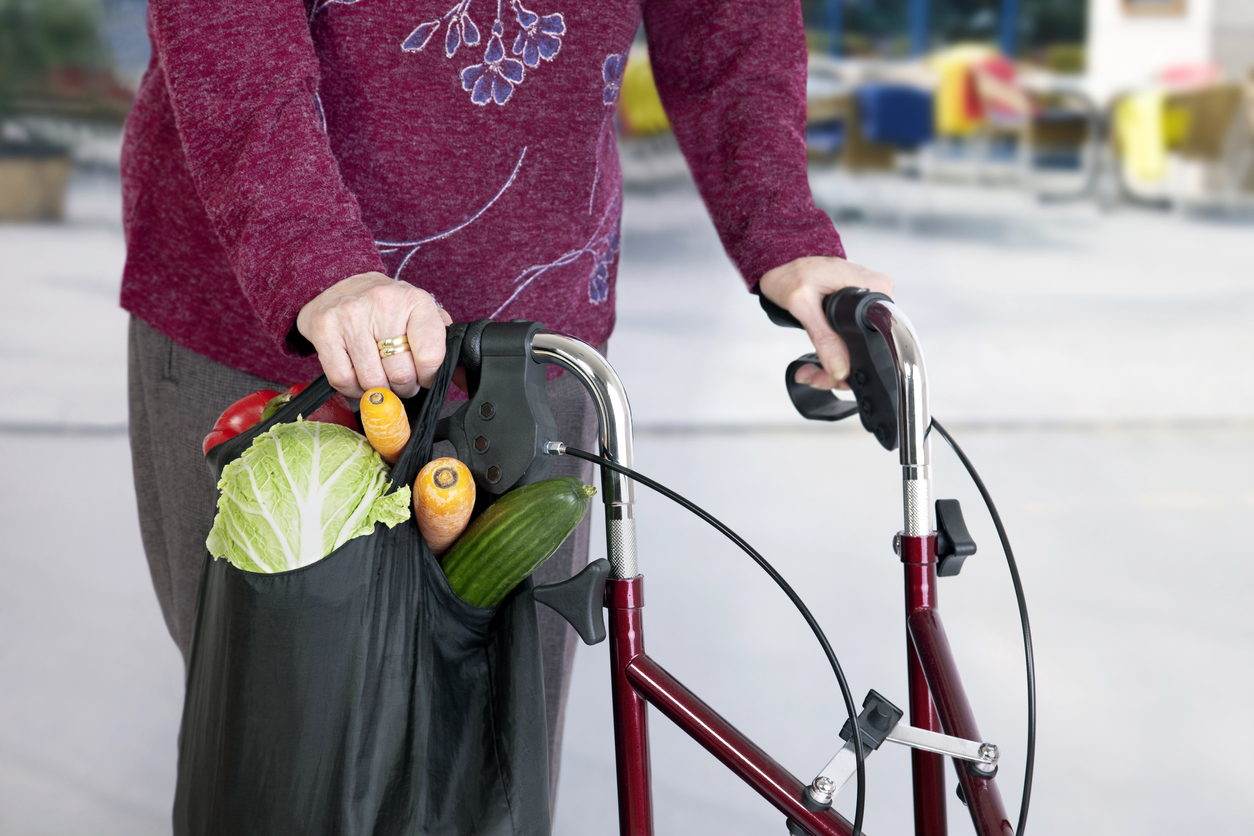 Stories and data can engage new partners and compel decisionmakers to take action.
Stories and data can engage new partners and compel decisionmakers to take action.
Invite community members to share their stories of exhausting bus rides with transfers or walking along streets with speeding traffic while carrying groceries.
Use photos to show street conditions; maps to illustrate inequities in sidewalks and bike lanes; and data on crashes to draw attention to streets and intersections that require safety improvements.
Transit agencies, for example, can incorporate access to essential services, like grocery stores, as a priority in service planning or when conducting an equity impact review of proposed changes.
4. Creating an Action Framework to Advance Safe Routes to Healthy Food
The task force’s report includes concrete steps to both bring healthy food closer to people and enable people to more safely and conveniently use active travel modes to reach healthy food retailers.
Cities, states, transit agencies, community coalitions and others can adopt a Safe Routes to Healthy Food Resolution, a policy that spells out a commitment to creating places where people can safely and easily walk, bike, and take transit to healthy food venues.
Consider transportation access as part of healthy food financing initiatives.
Use zoning codes to allow a variety of types of food retailers and use zoning incentives to attract healthy food retailers.
“When communities offer density bonuses or parking reductions for food retailers, it can provide a lucrative incentive for a retailer to locate in a certain area,” the report states.
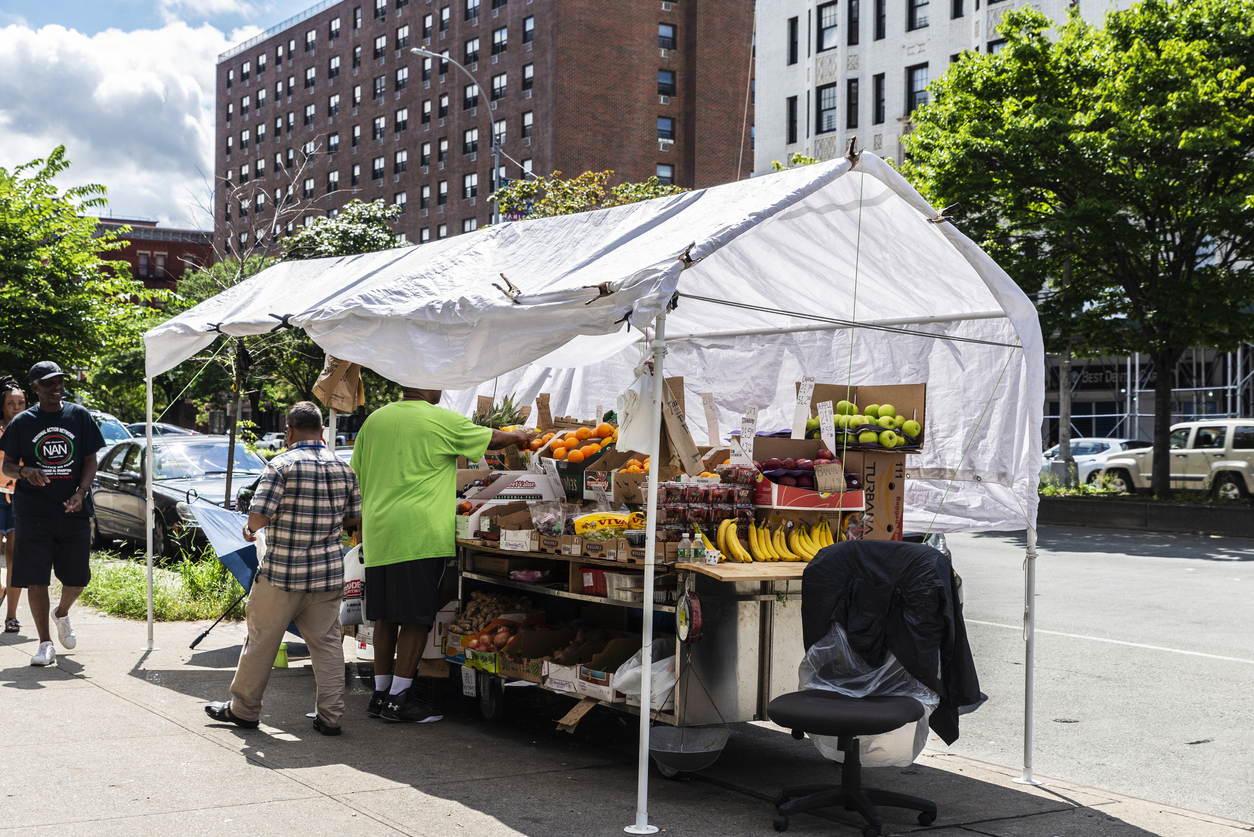 Improve active transportation and transit connectivity. Consider healthy food retail in active transportation and project planning and prioritization.
Improve active transportation and transit connectivity. Consider healthy food retail in active transportation and project planning and prioritization.
For example, consider healthy food access in sidewalk improvement planning, include multimodal healthy food access as a goal in Complete Streets policies, and consider healthy food venues as destinations in project scoring and prioritization.
“Transit agencies can be a key player in improving healthy food access by considering the location of healthy food venues as part of transit planning,” the report states.
Use comprehensive plans, master plans, and bicycle and pedestrian plans to bring safe routes and healthy food together.
Educate people about improvements, like a new bus route that connects a neighborhood to a grocery store or a new protected bike lane that connects a major employment center and a shopping plaza.
5. Driving Policy Recommendations among Government Leaders
The task force’s report outlines specific actions for five key sectors to promote walkable, bikeable, and transit-accessible healthy food access: local governments, state governments, public transit agencies, regional planning organizations, and public health.
Local government leaders can:
- Include health, active transportation, and healthy food access as priorities in long range plans, including Master Plans, Comprehensive Plans, and Bicycle and Pedestrian Plans.
- Update zoning codes to allow for mixed-use, dense, and infill development that promote connectivity of destinations and require supportive infrastructure for walking and bicycling, like sidewalks to require safe routes between the network of destinations. Ensure that food retailers are permissible land uses in these zones.
- Adopt a Transportation Demand Management Ordinance to require developers to design and construct developments that reduce vehicle miles traveled; tailor to support healthy food access.
- Include residents who are most affected by poor food access in official advisory/steering committees to advocate for, shape and help implement solutions for improving access to healthy foods through the ongoing process of planning and decision-making in their communities.
6. Driving Policy Recommendations among State Legislatures
The task force’s report also suggests that state legislatures can:
- Provide funding and technical assistance to local governments to update zoning codes, land use plans, and transportation plans to incorporate healthy food access and active transportation.
- As health or transportation agency initiatives, provide funding and technical assistance to localities to develop pedestrian plans that focus on equity, community engagement, and pedestrian access to healthy foods.
- Direct attention to the need for improved bicycle, pedestrian, and transit connections to places where people buy and obtain healthy foods.
7. Driving Policy Recommendations among Transit Agencies
The task force’s report also suggests that transit agencies can:
- Include improving food access as a goal in transit long range plans to set a vision for how transit agencies can meet the needs of riders and work toward those goals.
- Conduct internal assessments of how changing transit routes will affect riders’ ability to access essential services, like grocery stores, by incorporating this as a priority in service planning or when conducting an equity impact review of proposed changes. Provide space at transit stations for temporary sales of fresh produce and other healthy foods.
- Transit agencies can also use their real estate to promote safety, vibrancy, and a sense of place with transit-oriented development (TOD), either as landowners or as part of public-private partnerships.
To provide transit access to a new grocery store in Philadelphia, this developer and transit agency worked together extend two bus routes to the store and to build a designated island for passenger loading and unloading in the middle of the parking lot.
8. Driving Policy Recommendations among Regional Planning Organizations
The task force’s report also suggests that regional planning organizations can:
- Develop publicly available tools/metrics for analyzing transportation access to essential community services, including healthy food access.
- Add healthy food access to competitive project scoring sheets and provide extra points to transportation projects that improve healthy food access in such scoring and when developing project lists for Long Range Transportation Plans and Transportation Improvement Programs.
- Provide technical assistance to member governments on how to improve multimodal transportation options to healthy food venues.
9. Driving Policy Recommendations among Public Health Groups
The task force’s report also suggests that health departments and public health agencies can:
- Articulate Safe Routes to Healthy Food as a goal in agency planning and policies and dedicate staff time and resources to working toward improving it.
- Organize a meeting of local active transportation and food access stakeholders, and encourage a shift away from thinking about food access and active transportation as separate from one another, and discuss how the work could be strengthened by working together.
- Use data to show the need for Safe Routes to Healthy Food.
- Partner with local and state governments, transit agencies, and regional planning organizations to accomplish their strategies.
“Increasing access to healthy food can be achieved not only by bringing healthy foods closer to people, but also by making walking, biking, and transit a safer and more viable option to link people to where they get food,” according to the report.
What Can You Do for Safe Routes to Healthy Food?
Share the Safe Routes to Healthy Food Task Force’s new report, Safe Routes to Healthy Food Report and Action Agenda, with community leaders. See who might be interested in strengthening policies and practices to make it safer and more convenient to walk, bike, and take transit to access healthy foods.
Learn more about health equity issues in your community. Health equity is where everyone has a fair, just opportunity to be their healthiest.
Get a “Health Equity Report Card” to see how you can promote health equity in your area!
Select your county name and get a customized Health Equity Report Card by Salud America! at UT Health San Antonio. You will see how your area stacks up in housing, transit, poverty, health care, healthy food, and other health equity issues compared to the rest of your state and nation.
You can email your Health Equity Report Card, share it on social media, and use it to make the case for community change to boost health equity.
By The Numbers
27
percent
of Latinos rely on public transit (compared to 14% of whites).

